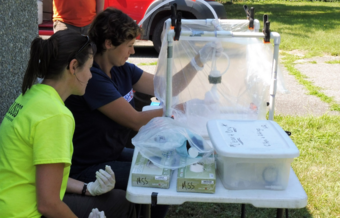USGS Hosts Scientists from Polish Geological Institute
In August, 2017, the US Geological Survey hosted a delegation from the Polish Geological Institute (PGI) to discuss techniques in sample collection and analysis of trace organics in groundwater.

The visit was focused on understanding the process of obtaining, handling, submitting, and analyzing groundwater samples for trace organic compounds, particularly contaminants of emerging concern (i.e. pharmaceuticals, hormones, etc.). This visit was a follow-up to several months of communication between the USGS and the PGI on potential collaboration, which included a web-based presentation by the USGS (Ed Furlong, Dana Kolpin, and Pat Phillips) to the PGI on emerging contaminant activities in groundwater by the USGS that was held in early 2017. One of the action items from this webinar was to have a follow-up visit by PGI to the USGS.
During the first week of the visit (August 14-18, 2017), PGI personnel spent a week observing and participating in water-quality sampling of groundwater for trace organics (Figure 1 and Figure 2) with the US Geological Survey in Coram, NY. The PGI delegation included Anna Kuczynska and Wojciech Wolkowicz from the Hydrogeology and Environmental Geology Program. The USGS field training was led by Irene Fisher, and aided by Shawn Fisher, Brendan McCarthy, and Patrick Phillips. The group discussed USGS field procedures (e.g. clean hands/dirty hands procedures), QA/QC protocols, and ongoing groundwater networks used for water-quality investigations in both Poland and Long Island, New York. The PGI research team obtained hands-on experience in field sampling activities collecting groundwater samples from two water supply wells in Suffolk County, New York including the collection and processing of water sampling according to USGS methods for trace organic sampling organics (e.g. pharmaceuticals, personal care products, hormones and other compounds).

The following week (August 21-24, 2017), Anna Kuczynska and Wojciech Wolkowicz travelled with Patrick Phillips to the US Geological Survey National Water Quality Laboratory (NWQL) in Denver, Colorado. They met with Ed Furlong, William Foreman, Eric Schwab, Mark Sandstrom, and James Gray in the Methods Research and Development Program; see Figure 3 and Figure 4. The PGI group toured the NWQL, and discussed existing and new analytical techniques for determining contaminants of emerging concern, pesticides, and other organic compounds in water samples. The focus on analytical techniques was primarily on the use of liquid chromatography with tandem mass spectrometry (LC/MS/MS) methods for determination of pharmaceuticals and pesticides in water, and gas chromatography with tandem mass spectrometry GC/MS/MS for a variety of other organic contaminants. The group discussed the advantages of the new small volume direct-aqueous injection LC/MS/MS methods for pharmaceuticals and pesticides that the NWQL has developed.
The participants agreed that the USGS visit was highly worthwhile in furthering the cooperation between the PGI and USGS. Future efforts will include discussions of technical issues in implementing sampling and chemical analysis of trace organics in groundwater samples in Poland, and potential future joint research collaboration. A plan for continued cooperation will be developed over the next few months that will likely include visits by PGI scientists to the USGS to obtain in-depth training on specific field sample collection techniques, corresponding field and QA/QC protocols, and analytical methodologies for measuring contaminants of emerging concern.


